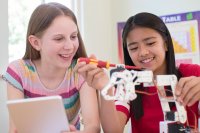Social and Emotional Learning in Science Class
The engineering design process offers a chance for students to develop skills like collaboration and cooperation.
You assign a group activity in your science classroom and within minutes, this scene unfolds: In each group of four students, two are talking to each other and semi-engaging in the task, one is entirely disengaged and is instead bending and reshaping a paperclip, and one is hurriedly completing the activity all alone, half-heartedly asking her peers to pass her the materials she needs. Sound familiar?
In science lessons, engineering activities can provide a great opportunity for students to collaborate and grow social and emotional skills in low-stakes, high-engagement environments. The creative, problem-solving nature of engineering encourages students to work together, try new ideas, and learn from their mistakes.
Preparation and Planning
Developing lesson plans for engineering activities to enhance social and emotional learning (SEL) requires first anticipating the abilities and needs of students, especially those who may not be on the same social or academic level as their peers.
Create or adapt roles to suit individual students’ abilities—this builds confidence and reduces the potential for peer resentment of a student who does not excel academically. This does not, however, mean that any one student always receives the lowest level job. Students who are reading below grade level may have access to an adapted passage or may use an app to have the text read aloud.
The goal is to anticipate what may hinder student participation and create opportunities to keep students engaged. Group work can lead to social isolation if a student is perceived to be not equally contributing, so offering opportunities for everyone to participate is important.
The engineering task you assign should require student interdependency. For example, establish the guideline that only one student is in charge of certain necessary materials, or that all students must complete a task for the goal to be met.
Create coaching questions that students can answer during the activity. Ask open-ended questions requiring reflection, to allow students to appreciate the social and emotional skills they’re using in real time. Possible questions include:
- What did you notice when...?
- How did [SEL skill] contribute to your success with...?
- How could [student]’s idea be incorporated?
You can prepare students for the social expectations by sharing examples of what successful collaboration looks and sounds like. Include some counterexamples to demonstrate the type of interaction you hope to avoid. Don’t be afraid to emphasize that collaboration will not always be easy and that we may not always like our teammates. This is real-world practice. Being open and transparent about science and SEL goals will show students you value their achievements in both areas.
During the Activity
As students progress through the activity, they should use the engineering design process, which guides students to test their ideas and then iterate solutions. Students can share a common road map, reference the process, and share a common vocabulary for discussion.
As you monitor student activity, be prepared for some social misunderstandings or students being left out, but do not solve these problems for your students. Instead, jump in with some coaching questions and support students through their struggles. Ask questions of students who seem less involved, so they can safely share their ideas in front of the group and be welcomed into the activity again.
In a recent lesson in my classroom, a young man who showed the most initial excitement was sitting solemnly at his group’s table. Instead of giving directives, I approached the group with questions—task-based at first, then reflective of the SEL components. When the team heard the young man answer some of the task-based questions, they voluntarily identified that they hadn’t been inclusive enough of his ideas. Had my approach been focused only on compliance, I would have demanded that he get to work without offering a path to resolve the SEL challenges of the team.
Pace the activity to allow for some social adjustments and communication. If we rush the process or solve the social dilemmas for our students, we rob them of an important opportunity for growth.
Reflect: What Went Right?
While reflection is incredibly important, it’s often the easiest step to omit. Save some time after the activity’s cleanup for a larger group conversation. Start simply by asking, “What went right?” Students can reflect on what they appreciated about the process and recognize the collaboration skills of their peers.
Deeper reflection topics include asking students to consider what strategies they used to communicate, how they solved any problems that emerged, and what they learned about each other or the process. Some teachers use a rubric for students to self-rate their SEL skills at different points in the year. Others allow teammates to give positive and constructive feedback to one another at the end of a project or lesson. Engaging students in evaluation helps them gain a deeper understanding of SEL skills and the nuances of their applications.
Solving social and emotional challenges shares many of the same steps as the engineering process: Students try an approach, evaluate how it works, adjust, and try again.
On the surface, social and emotional learning may not seem like an obvious fit for a science classroom, but scientists rarely work alone and need to use social and emotional skills when they propose a project for funding or share their results. Embedding SEL into an engineering activity can enhance your students’ success.
